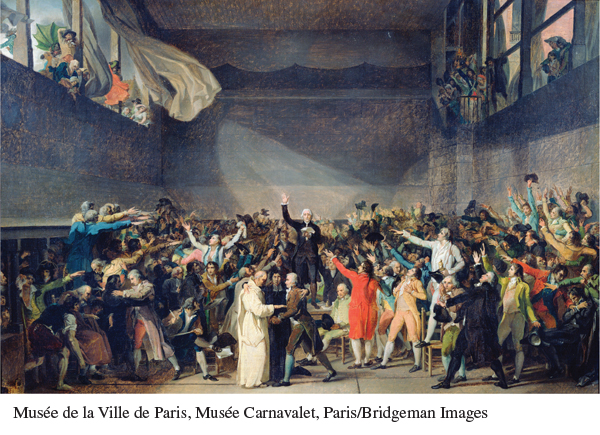A History of Western Society: Printed Page 619
A History of Western Society, Value Edition: Printed Page 596
A History of Western Society, Concise Edition: Printed Page 621
The Formation of the National Assembly
Spurred by a depressed economy and falling tax receipts, Louis XVI’s minister of finance revived old proposals to impose a general tax on all landed property as well as to form provincial assemblies to help administer the tax, and he convinced the king to call an assembly of notables in 1787 to gain support for the idea. The assembled notables, mainly aristocrats and high-
Facing imminent bankruptcy, the king tried to reassert his authority. He dismissed the notables and established new taxes by decree. The judges of the Parlement of Paris promptly declared the royal initiative null and void. When the king tried to exile the judges, a tremendous wave of protest swept the country. Frightened investors refused to advance more loans to the state. Finally in July 1788, a beaten Louis XVI bowed to public opinion and called for the Estates General. Absolute monarchy was collapsing.
As its name indicates, the Estates General was a legislative body with representatives from the three orders, or estates, of society: the clergy, nobility, and everyone else. Following centuries-

The petitions for change drafted by the assemblies showed a surprising degree of consensus about the key issues confronting the realm. In all three estates, voices spoke in favor of replacing absolutism with a constitutional monarchy in which laws and taxes would require the consent of the Estates General in regular meetings. There was also the strong feeling that individual liberties would have to be guaranteed by law and that economic regulations should be loosened.
On May 5, 1789, the twelve hundred delegates of the three estates gathered in Versailles for the opening session of the Estates General. Despite widespread hopes for serious reform, the Estates General quickly deadlocked over the issue of voting procedures. Controversy had begun during the electoral process itself, when the government confirmed that, following precedent, each estate should meet and vote separately. During the lead-
In angry response, in June 1789 delegates of the third estate refused to meet until the king ordered the clergy and nobility to sit with them in a single body. On June 17 the third estate, which had been joined by a few parish priests, voted to call itself the National Assembly. On June 20, excluded from their hall because of “repairs,” the delegates moved to a large indoor tennis court where they swore the famous Tennis Court Oath, pledging not to disband until they had been recognized as a national assembly and had written a new constitution.

The king’s response was disastrously ambivalent. On June 23 he made a conciliatory speech urging reforms, and four days later he ordered the three estates to meet together. At the same time, Louis apparently followed the advice of relatives and court nobles who urged him to dissolve the Assembly by force. The king called an army of eighteen thousand troops toward the capital to bring the delegates under control, and on July 11 he dismissed his finance minister and other more liberal ministers. It appeared that the monarchy was prepared to use violence to restore its control.